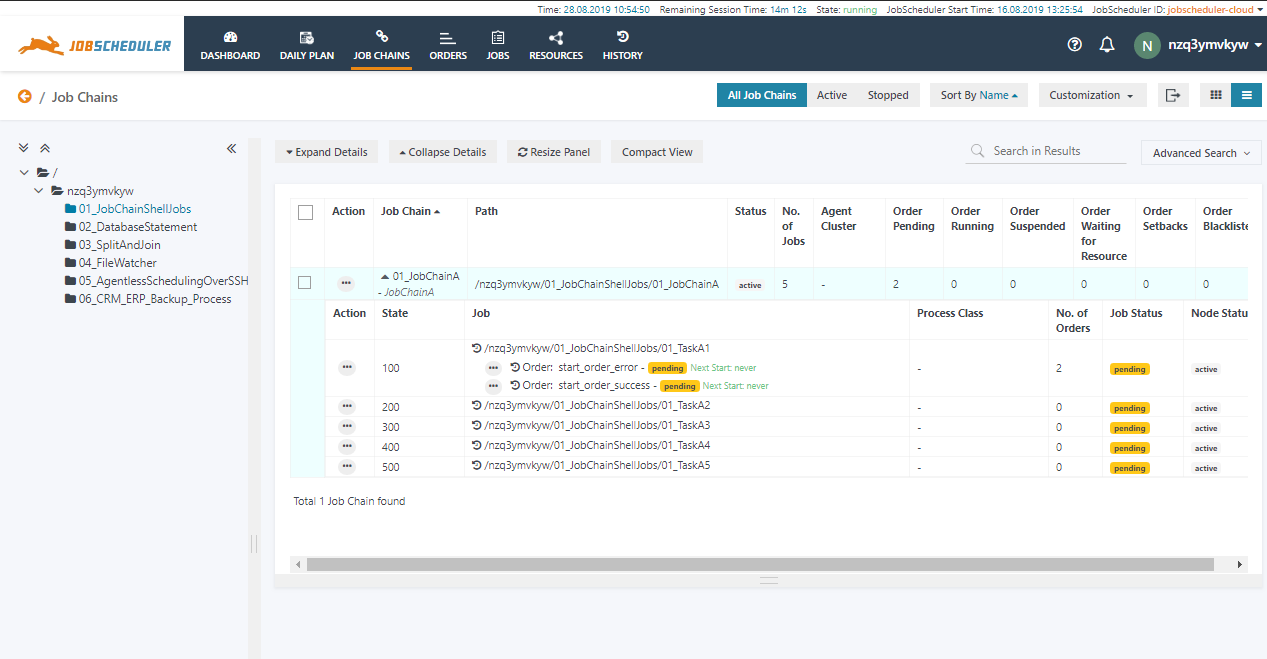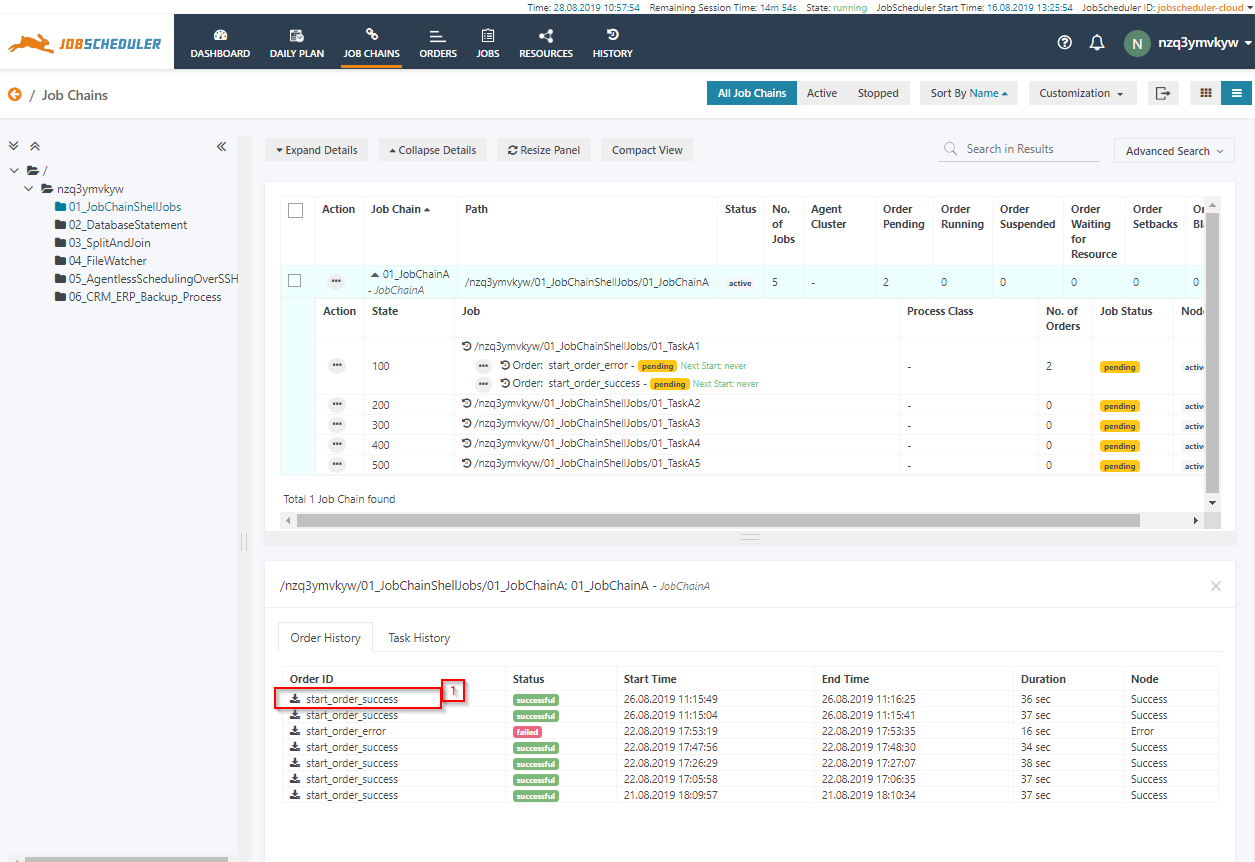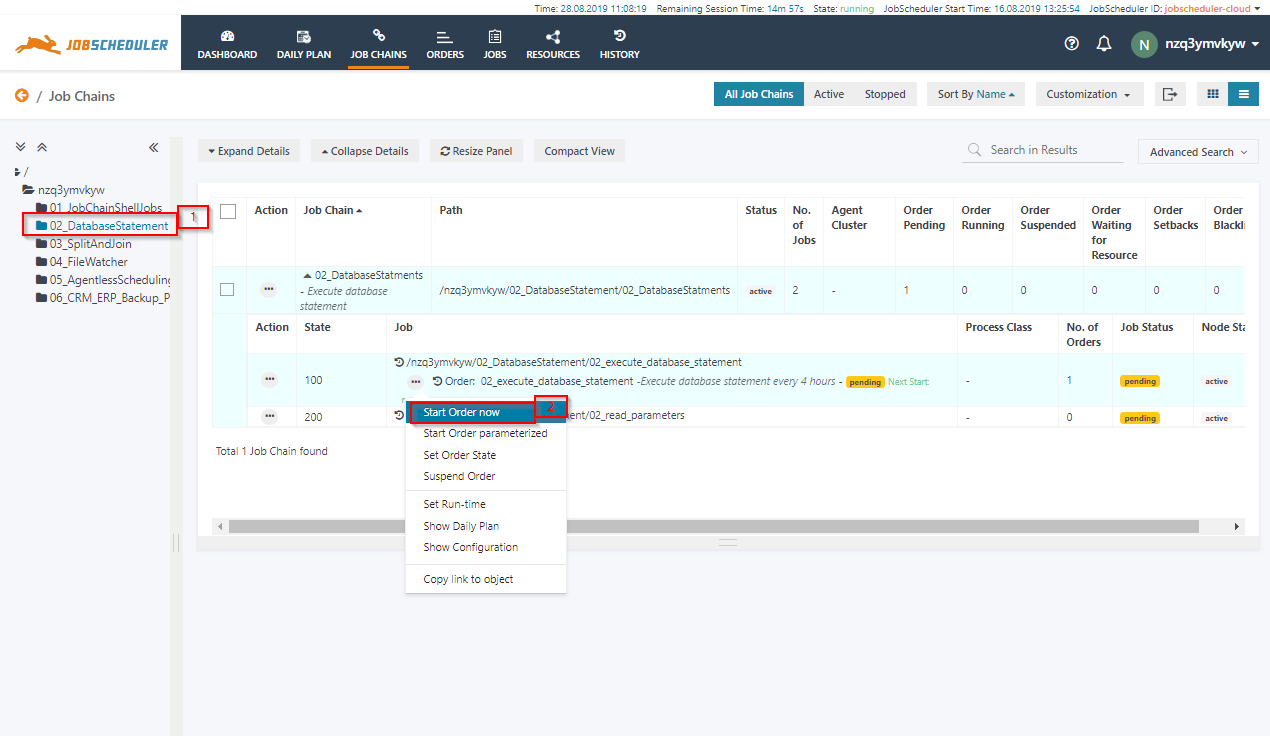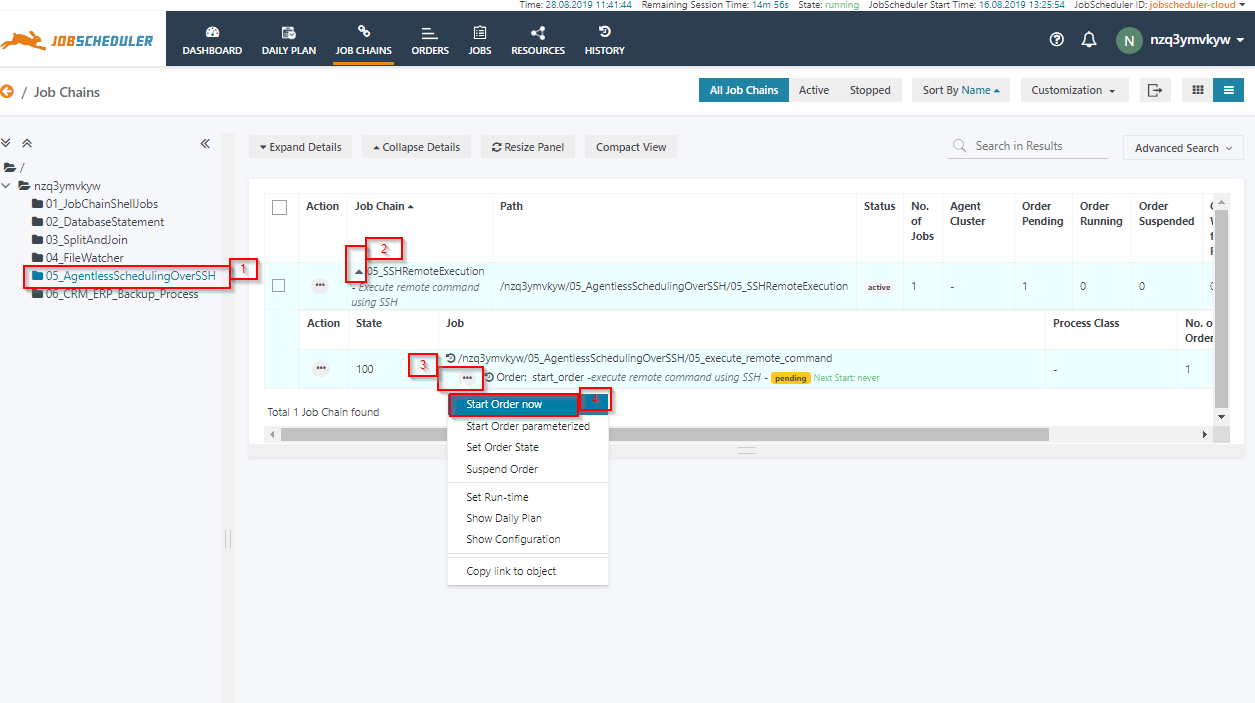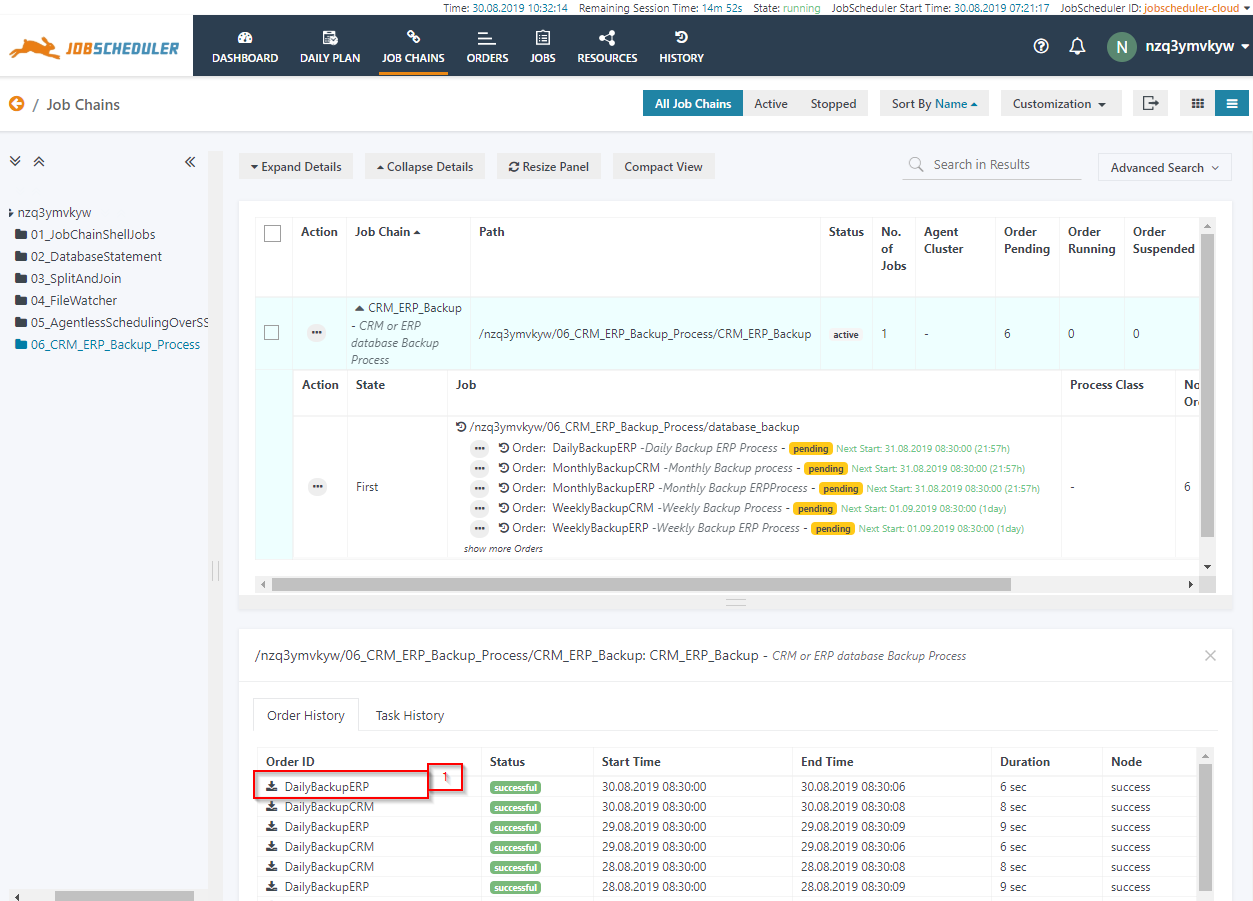Introduction
On using the Try Out option form, sos-berlin.com user gets an invitation link on their registered email id for using JobScheduler demo.
After clicking on the Try-Out: Login JOC Cockpit, you will be presented with the JobScheduler Operations Center ( JOC) Login. Use the Account and Password you have received with the Welcome Email to login into the JobScheduler demo environment.
After Login you will be presented the first view, which is referred to as the "Dashboard View". The Dashboard gives a bird's eye view of JobScheduler operational status.
To Run the Job Chain from the JOC-Cockpit, you need to switch the tab to Job Chains view.
Click on JOB CHAINS tab, JOC will switch the view to display the Job chains. To expand the list of folders and to see the available job chains, in the left tree navigation, Click on the arrow, refer KB article to know more about JOC Cockpit - Navigation and Usability.
After expanding, the top folder will show the subfolders, each contains one or more Job chains.
All the examples in the demo environment follow the same pattern. Each job chain demonstrates an important JobScheduler feature, and most of the job chain has a minimum of two Orders to simulate successful and failed processing.
Shell Script Job
The example 01_JobChainShellJob demonstrate JobScheduler capability to execute shell jobs.
- To start the example, first, we need to list all the job chains in the folder. To list, the job chains under the subfolder, click on folder e.g., 01_JobChainShellJob. The list of Job chain will appear at the right-side panel.
- 01_JobChainShellJob: job chain contains simple order jobs with a shell script as executable. The Job chain contains two permanent order to run start the job chain with “success” and “error” processing status. [SCREEN SHOTS]
The JobChain“01_JobChainShellJobs” has 5 Jobs with 2 orders (order_for_success, order_for_error).
The order “start_order_success” will simulate a successful processing and the order “start_order_error" with trigger processing with an error.
To run the any order
- Click on the action menu of order. A drop-down menu will appear.
- Click on Start Order now option to run the order immediately. The order will start, you can see the order steeping through from one Job to then next job.
- Click on the action menu of order. A drop-down menu will appear.
To check the status of the order
- Click on Job chain name "01_JobChainShellJobs."
- Order History panel will open at the bottom section of the job chain view with the list of the order history. The Order history panel shows current order log and previous runs too.
- To see the last execution of order or to view the log of the running order.
- Click on “start_order_success” Order Id to access the log from last run of the Order.
- A log window will open, complete Order log will be displayed. The order log contain log output from all the jobs executed by the order.
- User can also download log file by click Download button from the right corner of the log window.
- Click on “start_order_success” Order Id to access the log from last run of the Order.
Execute Database Statements
The JobschedulerManagedDatabase is a JITL job, it can be used to execute an SQL statement or SQL scripts on varied RDBMS database systems. The JobSchedulerManagedDatabase job abstract the complexity of executing SQL statements/scripts on any RDMBS system. The JITL job uses the Java hibernate to connect and execute the statements.
In this example, we are executing a simple SQL statement on the JobScheduler Database to get the JobScheduler Host and URL. The JobSchedulerManagedDatabase has the capability to convert results of SQL statement into order parameters which can be read by successive jobs in the job chain. This example demonstrates the feature where results from SQL statement will be available to next job step as order parameters e.g. JobScheduler Host and URL values
To run the job chain.
- Click on job chain “02_DatabaseStatement” and expand the job chain details
- Click on job chain “02_DatabaseStatement” and expand the job chain details
To run order manually.
- Click on the action menu of order. A drop-down menu will appear.
- Click on Start Order now option to run the order immediately.
- To check the status of the order
- Click on Job chain name "02_DatabaseStatements "
- New Order History panel will open to show the order history.
- You can see that the database statement was executed on the database and the results are transferred to the next job as order parameters.
File Watching
JobScheduler has inbuilt File Watching feature which enables automating business process based in arrive of files. The file watching job chain starts automatically as soon as a file matching with regular expression arrives in a specific folder. Once the job chain is triggered by the file, the complete file path will be available on the job as an environment variable which can be passed to the application executed by subsequent for reference.
- To see the working 04_filewatcher job chain we need to create some files which will trigger the job chain, first, expand the folder and list all the job chains
- Start the order "start" manually in the job chain 04_FileWatcher/04_generate_files
- This will generate five files in the incoming folder which automatically trigger the job chain 04_filewatcher
- To check the status of the file watcher order
- Click on Job chain name "04_ LoadDWH"
- New Order History panel will open to show the order history.
Agentless Scheduling
JobScheduler has feature-rich Agent Scheduling capability using JobScheduler Universal Agent. Along with JobScheduler universal agent, JobScheduler also supports the agentless scheduling over SSH.
This example demonstrates the simple example of executing a shell command on a remote server over SSH. The JobScheduler JITL job JobSchedulerSSHJob is an inbuilt interface to execute tasks over SSH. Read more about JobSchedulerSSHJob parameterization on KB article Example for the JobScheduler SSH Job
Start the Job
- Start the order “start_order” which will start the job 05_execute_remote_command.
- The job 05_execute_remote_command will connect with the remote host and will execute simple shell command “env | sort”, the results from the command will be stored in the log files.
- To open the log file.
- Click on the job chain name "05_SSHRemoteExecution", new order history panel will open
- Click on the order "start_order" to open the log window.
- Click on the job chain name "05_SSHRemoteExecution", new order history panel will open
Multiple Order and Order Parameter
This example demonstrate the JobScheduler feature of multiple orders assigned to a single job chain and order parameters. JobScheduler job chains can be reused by assigning multiple orders consist of different parameter set, which in turn reduce the number of identical job configuration. the job chain, "06CrmErpBackupProcess" one single job accept parameters is configured with multiple orders in it.
The JobScheduler feature can be used in a classic database backup process, One of the most common use case is the database backup job chains, for example to backup two databases e.g., ERP and CRM databases, with the frequency of Daily, Weekly and Monthly. A job chain can be configured to reuse the database backup job by parameters from the orders. When the order will start the parameters from order will be available to the job as environment variables.
06CrmErpBackupProcess
In the job chain “06CrmErpBackupProcess” the multiple order is used with multiple parameters. Which run on the Daily, weekly and Monthly basic to
- DailyBackup orders: The orders executed daily according to runtime time of orders.
- WeeklyBackup orders: The orders run weekly according (mostly executed in free time Saturday or Sunday) to the runtime of orders.
- MonthlyBackup: The orders will execute on the last day on the month
To run the job chain.
- Click on job chain “06_CRM_ERP_Backup_Process” and expand the job chain details
To add run job chain manually
- Click on the action menu of any order e.g. “DailyBackupERP”. A drop-down menu will open.
- Click on Start Order now to start the order.
To check the status of the order
- Click on JobChain name "CRM_ERP_Backup"
- New Order History panel will open to show the order history.
You can also review the log of the running order.
- Click on “DailyBackupERP” order to open logs from order history tab.
- The log window will open, and the complete Order log will be shown

